Interview: Koji Yamamoto, Ryo Ohyama, and George Wada on Guilty Crown
by David Cabrera,
After the New York Comic Con premiere of the first two episodes of the new Guilty Crown anime, I sat down with Chief Producers Kōji Yamamoto and Ryo Ohyama, Production I.G's George Wada. Aniplex USA's Yosuke Kodaka interpreted. Guilty Crown is available streaming at Funimation.com and Niconico.com.
Cabrera: The first thing I heard about this show is that it's running in the Noitamina block. I was a little surprised because it's different from the kind of fare that (usually) runs in Noitamina, and I'd like to know from the producers: what is the demographic for Guilty Crown?
Yamamoto: The block was originally one show only, but Fuji TV expanded it to one hour, and eventually they were trying to create a more widely-accepted title. So Guilty Crown is one of the titles that's being created to do that.
Ohyama: We're stressing action and plot: a cutting-edge TV show. The first show we took this approach with was Shiki, and that was the beginning of that.
Wada: One of the most important things is that we wanted to do an original series. So, from a studio's point of view, we wanted to create the next generation of anime with this show. With Ghost in the Shell, the main audience is twenties to thirties, but with Guilty Crown we're going for a younger audience.
Along those lines, I noticed that redjuice does the character designs and Ryo does the music. They're both very popular, not so much in established animation but in the net community, and I was wondering whose idea it was to get them for the show.
Yamamoto: It was the whole staff, including Mr. Araki (director). We felt that he (redjuice) had great potential to do very well and have a wide appeal with people.
Ohyama: After redjuice signed on as designer, since he's part of supercell, Ryo also signed on. ()
Ah, so they came as a set. I know that the show is scheduled for two seasons, and a two-season show is [considered] risky. Did you see a two-season series like Guilty Crown as a risk in terms of length?
Yamamoto: There is, of course, a very big risk to doing a two-season show, and to doing something original. But if we go for one season, it'll just begin and end. So for this show, and from now on, we want to do more two-season shows.
I noticed while watching the show that it has a lot of ideas that are very specifically Japanese, such as foreign independence and national pride in general. How do you think this is going to play with a foreign audience? Do you think they'll still be able to connect?
Yamamoto: The basic concept of the show is in a Japanese style, a Japanese concept, and that is what makes it more original than other shows. So as a worldwide show, the Japanese element is very important.
On that same note, but lately there have been a lot of articles about the “herbivore” male, or “passive youth”. I was reminded of this sort of personality when I saw the hero in the show. I wanted to ask you personally, do you think of this hero as a “herbivore male”?
(A comparison to Evangelion's Shinji Ikari came up when this question was being interpreted)
Ohyama: Shu is one of the main characters, but there's also one more main character – Gai - and they're completely opposite types of people. As for Ikari Shinji, that's a show from 1995, and Shinji is more passive. They're both in their own world and they don't come out from that world. So Shu is kind of a 2011 version of Shinji: he has more of a--
[the group breaks into laughter]
He has friends, but he doesn't have connections with them yet. The relationships are skin-deep. That's more of a 2011 type, nowadays, of a 17-year-old boy. So that's the difference between Shu and Shinji.
When I watched the first episode of the show I immediately went online to see what the fan reaction was, and there was a huge amount of comparison to Code Geass. The shows share a writer, but my question is: going forward with Guilty Crown, how you plan on differentiating yourselves from Geass to the fans?
All: Where are you seeing this?
The plot outline, the districts, Japan being undermined, and the boy meeting a girl who grants him power.
Yamamoto: We're not trying to be like Geass. We didn't plan to take anything from it for this show. Actually, as for the setting, Code Geass is quite apart from, way beyond modern Japan. But for Guilty Crown, the situation is more natural. So we're not trying to do a similar plot. Of course, there are some similarities.
Thank you all so much.
All: Thank you.
Thanks to Aniplex and Funimation for setting up this opportunity.
discuss this in the forum (57 posts) |